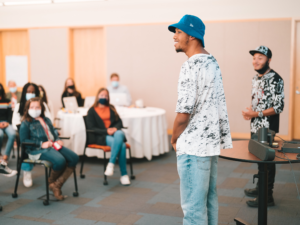Teaching Students How to Work Together

The future of work is rapidly changing, largely due to Artificial Intelligence. Getting Smart recently released a paper and microsite explaining the impact that Artificial Intelligence will have on the future workplace. This quote from the report stood out to me: “The abilities to read social situations and develop productive relationships are, for the foreseeable future, uniquely human skills, and will become increasingly important and valuable in an automation economy (p. 23).” It is clear that our students will need to be able to work effectively with others to succeed in the future workforce.
Group work has been on my mind for years. I was curious about how my students felt about working together in groups, so I started class one day by asking them to list what they liked and disliked about working in groups. Their responses were eye-opening:

As teachers, we sometimes assume that students will just figure out how to work together, but we may not be preparing our students for the future workforce if we don’t teach them teamwork skills. I was determined to figure out how to do this.
Two books were most impactful in informing my strategies: Designing Groupwork: Strategies for the Heterogeneous Classroom by Elizabeth G. Cohen and Mathematical Mindsets: Unleashing Students’ Potential through Creative Math, Inspiring Messages and Innovative Teaching by Jo Boaler. Both authors make the important point that we should be TEACHING our students how to work in groups. As with teaching any other topic, learning does not happen in a day. We need to give students plenty of time to practice.
Both authors suggested giving students roles when they work in groups. I decided to call my groups “teams,” aiming for teams of four students where possible. I used examples from both books to put together roles for my team members, although the roles most closely resemble those in the Mathematical Mindsets book. Each role has a name and specific responsibilities:
- Head Coach: Make sure everyone understands the directions for the activity and stays together throughout the activity. Make sure everyone understands the solution to the activity well enough to explain it to others.
- Journalist: Lead the team through organizing results and creating the final product (poster, presentation, etc.). The teacher will call a meeting of journalists if any new information needs to be given to the teams.
- Resource Manager: Get supplies for the team. This is the only person who can ask questions of the teacher after first ensuring that the question is truly a team question, not just an individual question.
- Assistant Coach: Make sure everyone gets equal time to share their ideas, invite each team member by name to contribute, and ensure the team conversation stays within the group.
Based upon suggestions in these books, I also created a list of expectations for how teams should work together: ask questions, share drawings/equations/ideas, listen, don’t leave anyone behind, give every team member equal time to talk, and ensure everyone understands the details. I also mentioned that positive body language is critical: sitting together and working closely at the same table is more effective than sitting away from your team and staring at your own paper.
I thought that this new approach to group work would have the best chance of success if I first gained student buy-in. Before working on a group activity, I showed the class their list of likes and dislikes about working in groups. I presented the roles and expectations as a solution to address their concerns and I could see that they were interested in trying it out.
Once we got started, the biggest struggle for my students concerned asking questions of the teacher. Only one person has the role of asking questions, and all questions must be team questions. At first, random students in each team called me over to ask questions. If they were not the resource manager, I reminded them that all questions must be group questions and must be asked by the resource manager. While this initially frustrated some students, it forced them to talk to each other. Sometimes I heard the resource manager practice the exact wording of a question to ask, carefully repeating the words of a teammate. When the resource manager called me over, I asked if they discussed the question yet as a group. Typically they had not, so I reminded them to discuss the question first as a group. It took some time and practice, but the teams eventually got comfortable posing questions to each other instead of to me. They only asked questions of me that the team agreed they could not answer and were critical to moving ahead.

Students usually take their roles very seriously and work hard to ensure everyone is involved and understands. But nothing is perfect: sometimes there is a team member who gets left out, decides to work on their own, or does not understand what the group is doing. Both books provide strategies to deal with this. Here’s what I have tried:
- First, I call over the journalists and ask them to remind the head and assistant coaches to ensure everyone is involved and understands the discussions of the team. I tell them that is important to invite each student, using their name, to give their thoughts or ideas.
- If this doesn’t work, I call the journalists over again and tell them that I plan to observe each group and give them a grade for how well they are meeting our teamwork expectations. These are quick observations, and I hand each group a letter grade with comments as I walk away. While I’ve never actually recorded a grade that I’ve given, I find that the mention of a grade is enough to remind most students to work to meet expectations.

Since I started using these roles, I have seen a positive improvement in how well my students work together. Keep in mind that it does take time. It is also important to maintain student buy-in, so after each activity, I ask for their feedback. What worked? What didn’t work? Should any of the roles be altered? How can we improve group work next time? This step can be done together or via a survey, but it is critical to keeping student ownership.
The group work structure and opportunities to practice may prove to be invaluable for students to learn how to work effectively with others so that they can succeed in the future workforce.
For more, see:
- Balancing Choice, Collaboration and Community
- 10 EdTech Tools for Encouraging Classroom Collaboration
- Teaching Collaboration Through Preparation and Project-Based Learning
Stay in-the-know with all things EdTech and innovations in learning by signing up to receive the weekly Smart Update.








Mike
Hello Jamie,
Thank you so much for sharing to us such an insightful article it wraps everything that I wanted to know about working together in groups, I am a university student, recently we were given a project to work with so when I perused through this article it really gave me a vivid picture of how I show work closely and together with my colleagues.
Thank you much appreciated!